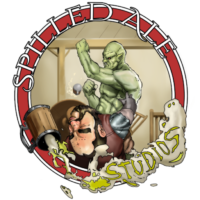Fifth Edition Fallout
Since this series was completed, the reskins and rules discussed have been compiled into a single sourcebook I’ve called Fifth Edition Fallout, which also includes new additions conceived after the conclusion of the series, as well as a bestiary of wasteland creatures! You can find Fifth Edition Fallout, a starter adventure called A Date With the Queen, and several resources including a tailor-made character sheet over at the Fifth Edition Fallout hub page.
This is the second in a series of articles discussing how we might hack 5th edition D&D to allow us to play games set in the Fallout setting. You can find the first part here.
This time round, we were meant to be looking at classes. But we’re not going to, because I realised there was something else we needed to cover first.
You see, I’d written the article on classes already and had moved on to equipment. Thinking about items made me realise there were several important features of the Fallout setting that I’d neglected to consider during my introduction to the key concepts we need to consider for this hack. As you might imagine given I realised this while thinking about equipment, these neglected features pertain to the resources available to characters—and the lack of them. So we’re going to cover these ideas and build any mechanics we need to support them now while core ideas and mechanics are still at the forefront, rather than interrupt the flow of the series later when we’re delving into specifics.
That said, this is perfect illustration of the fact that hacking a game (or developing one from scratch) is an organic process. Sure, I can set out an ideal order in which to write this series, but I can’t make any guarantees regarding that road map. Whether it’s something I suddenly realise needs to be included, an idea that comes to me be based on something we develop later that needs to be retroactively accounted for, or the realisation late in the game that something decided early doesn’t work after all resulting in beginning again from scratch, complications arise. I was fortunate on this occasion to have such a realisation at a convenient time. Next time might not be so lucky.
Scarcity
Theme versus Fun
Food and Water
Food is abstracted into meals, drinks, and snacks. Players should either keep track of their own food and drink supplies or the group may designate a volunteer as their quartermaster.
Starvation and Deydration
A character needs at least two meals worth of sustenance and two bottles worth of water (or equivalent hydration) each in-game day.
Returning to an Adequate Diet
Returning to an Adequate Level of Hydration
Snacks
Radioactive Food and Drink
Whether canned or bottled goods from before the Great War, or grown or sourced in the post-nuclear wastes, almost all sources of food and drink available are irradiated. All meals and bottles are assumed to be radioactive unless the GM specifies otherwise.
When a character consumes radioactive food or liquid on any given day, at the beginning of the next day (usually after their next long rest) they make a DC 10 Constitution saving throw. On a failed saving throw, the character gains a level of radiation poisoning.
If a character is fortunate enough to partake of fresh food or purified drink for some but not all of their daily rations, reduce the DC by 1 per non-radioactive meal or drink consumed that day. Naturally, if all meals and drinks consumed are non-radioactive, no saving throw is required.
Skipping a meal or drink also reduces the DC by 1. Eating and drinking nothing avoids the saving throw altogether. Abstaining from irradiated food and drink can work for avoiding the risks of radiation poisoning in the short them, though it means the character may instead face the consequences of starvation and dehydration (see above).
Salvage
In Fallout, especially in the early game, players might be inclined to pick up all kinds of junk items to sell at a market for as many caps as they can squeeze out of the vendor. In Fallout 4, junk has another purpose too—it can be broken down into parts to upgrade weapons and armour with modification. Spoiler alert—I intend to include modifications when I get round to equipment. Players will either be able to pay an appropriate NPC using caps, or do the job themselves if they have the raw materials, perhaps after making an appropriate skill check or checks.
So do players need to keep track of every broken watch or zippo lighter they pick up from the wasteland?
I’m thinking there’s no need for that. Instead, I propose an abstracted resource called “salvage”. The GM can award this to players by way of loot along with caps and items as part of an adventure. Each point of salvage represents one unspecified item or the broken down components of said item.
Salvage can affect encumbrance. A character’s salvage has a weight of 0.4 lb. multiplied by the number of salvage points.
Many traders will gladly buy salvage. Typically, one salvage is worth one cap, though like any other item player characters may find that market values sometimes vary.
Finally, salvage can be expended to modify weapons and armour. To create a modification, a number of salvage equal to the modification’s price in caps must be consumed.
Ammunition
We could also abstract ammunition in the same way (this is the approach taken in the Dungeon Master’s Guide, where all guns simply use “bullets”), but I feel that ammo is one area of the game that would be poorly served by this approach.
If all weapons use the same bullets, it will be hard to ever tax the resources of our players without crippling the party’s ability to use guns entirely. A rich variety of ammunition, on the other hand, is a potent tool in the GM’s arsenal to carefully control the ammo supply and encourage the theme of survival.
In D&D, characters tend to stick to one or two weapons, which are their signature items. If they change it, it’s just because they found a better, magical version.
This Fallout game shouldn’t really be like that. It’s fine if they have a favourite, but players shouldn’t rely too much on any one weapon. It should sometimes be unavailable because of lack of ammunition or disrepair; characters should carry back ups, and be willing to pick up whatever weapons and ammo they can find on site in the name of survival. We want our players to feel like scavengers who survive on their wits, and making the best of the tools they have, rather than being carried through a situation because they are always optimally equipped.
When ammo is broken up into many types, we can hand out the ammunition the players really want—the caliber they need for their first choice weapons—in carefully portioned amounts. If they never get enough of it, they’ll be encouraged to carry backup ranged and melee weapon to give themselves options in a pinch. If they find a weapon they wouldn’t normally use, they’ll be more likely to consider using it, even if only temporarily. Especially if there’s more ammunition for that particular weapon lying around, which is usually the case.
Even when they do have ammo for their preferred weapon, players might carefully consider whether they really want to use it—”is this pack of mole rats worth using my precious shotgun shells, or should I switch to my pipe pistol and save the shotgun in case something worse is just around the corner?”. The party as a whole may even start making such choices together, each equipping themselves with different types of weapons to their comrades so that they aren’t competing for precious ammo supplies, and each taking the lead in a given situation depending on who is best equipped to handle it.
On that note, we can occasionally use ammo supplies to give each character a moment to shine. One day, Hannah might use her shotgun to fend off a mirelurk while her ammo-starved companions retreat to safety. The next, it might be Jerome’s turn to protect the party from a pack of feral ghouls using his assault rifle.
For these reasons I favour specificity over abstraction for ammunition, and that’ll be the approach I take when creating the equipment lists.
Next Time…
That’s it for now, though as I mentioned it’s still possible I’ll realise something else I missed that’s too important to ignore! Fingers crossed it doesn’t happen. Fates willing, next time we’ll be returning to the original schedule and taking a look at what classes and archetypes might work for our Fallout themed game.

